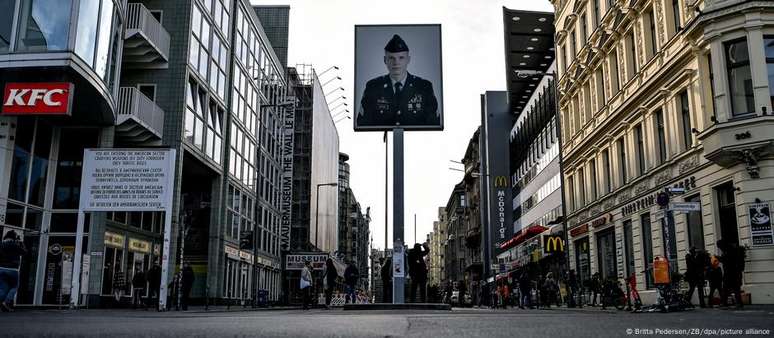The United States, the United Kingdom, France and the Soviet Union occupied the German capital at the end of World War II, leaving it for good only in 1994. Traces of that time, however, are still everywhere. The coalition troops that defeated Adolf Hitler during World War II (1939-1945) spent almost half a century stationed in Germany.
It all began on May 8, 1945, the day of the unconditional surrender of the Third Reich to the Allied forces. It was the end of one of the worst conflicts in history, which cost at least 60 million lives and was caused by the Nazis.
Shortly thereafter, on August 2 of the same year, Germany was divided into four zones by the victorious powers. The United States, the United Kingdom, and France took the western part of the country, while the Soviet Union took the eastern part; the former gave rise to the Federal Republic of Germany (FRG) in 1949, while the latter became the German Democratic Republic (GDR), a democratic communist dictatorship in name only.
A Berlin divided into four sectors
The former capital of the Nazi Reich was also divided into four sectors by the Allies and during that period tensions began to grow between the victorious powers of the war.
From the military alliance forged for convenience emerged two enemy camps: the democratic one, of the Western allies, and the communist one, of the Soviet Union. And it is in Berlin that these tensions emerge most intensely, with the Soviet blockade of the western sectors in June 1948. The objective: to take control of the entire city.
The Airlift That Saved West Berlin
The United States, the United Kingdom and France responded to the blockade with the legendary Berlin Airlift.
To ensure the survival of the 2.2 million citizens in the western sectors, the planes supplied the city with all sorts of goods: food, medicine, fuel, coal to keep the houses warm. The planes were affectionately nicknamed by Berliners Rosinenbomber, or “raisin bombers,” an allusion to the packages full of sweets that American soldiers dropped on the city before landing, which made the children happy.
Plane crashes and other accidents related to the action killed around 100 people: the victims are remembered at the Airlift Memorial (Luftbrücken-Denkmal) at the old Tempelhof Airport, where some Allied planes landed.
The airlift lasted until the end of the blockade in May 1949. The story of this logistical feat is told in the permanent exhibition at the Allied Museum (Alliierten-Museum), in the former American sector.
A cinema for soldiers turned into a museum
The property that houses the Allied Museum is historic: there was the Outpost cinema, which served American soldiers. And the avenue where the museum is located, Clayallee, is a tribute to the organizer of the airlift, American general Lucius D. Clay.
Checkpoint Charlie: A Tourist Magnet
There is also the famous Checkpoint Charlie, a former military post on the border between West and East Berlin.
Today it is a must-see for anyone visiting Berlin. Many people have their picture taken in front of the replica: the original is located in the Museu dos Aliados.
Built after the construction of the Berlin Wall on August 13, 1961, it was the place where soldiers of the Allied forces and diplomats moved freely between the two parts of the city. During that period the place became the scene of an impressive clash between American and Soviet tanks.
Cisterns and tombs next to the Brandenburg Gate
And speaking of tanks, there are a few of them scattered around Berlin.
One is located in front of the Berlin-Karlshorst Museum, in the former Soviet sector. The highlight of the permanent exhibition is the Capitulation Hall (Kapitulationssaal), where the end of the Second World War was sealed on 8 May 1945.
The Soviet War Memorial next to the Brandenburg Gate is also surrounded by tanks. At least 2,000 Red Army soldiers who fell in the Battle of Berlin, fought between April 16 and May 2, 1945, are also buried there.
The military airfield at Gatow, in the former British sector, still bears witness to the Allied presence. The Royal Air Force remained stationed here until the final departure of the troops on 8 September 1994. Today the site is a protected historical monument and houses the German Army Museum (Museum der Bundeswehr).
Planes no longer land at Tempelhof and Tegel
Gatow has been without air traffic for a long time, as have the other two airports in the American and French sectors that were used for military and civilian purposes at the time: Tempelhof and Tegel. There today you can learn about the twists and turns of the Allies’ history.
A special attraction is expected to reopen in November this year, after being restored: the 13-meter-high wooden replica of the Eiffel Tower, which decorates the entrance to the French Centre, in the Wedding district. The cultural institution was opened in 1961 and is today dedicated to promoting Franco-German friendship.
Street names recall the past
It has been 30 years since the last soldiers of the Allied forces of World War II left Berlin. Part of the barracks they left are now used by the German armed forces.
The legacy of the Allies is visible mainly in historical landmarks. But there are other curious traces, which surprise especially the uninitiated. One such place is Cité Foch, a former residential complex in the Reinickendorf district used by French military personnel. There, the past lives on in the names of the streets: Avenue Charles de Gaulle, Place Molière, Rue Montesquieu.
Source: Terra
Rose James is a Gossipify movie and series reviewer known for her in-depth analysis and unique perspective on the latest releases. With a background in film studies, she provides engaging and informative reviews, and keeps readers up to date with industry trends and emerging talents.





